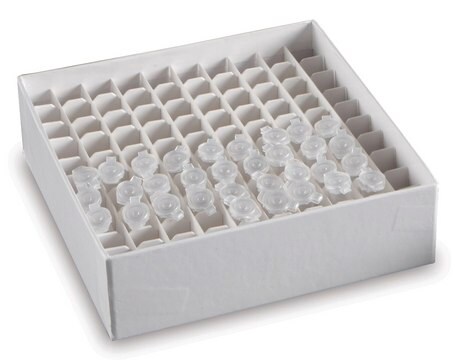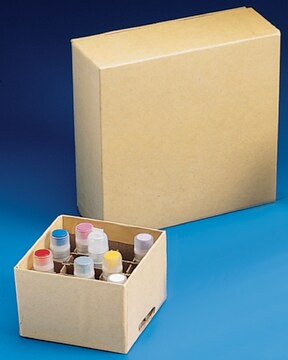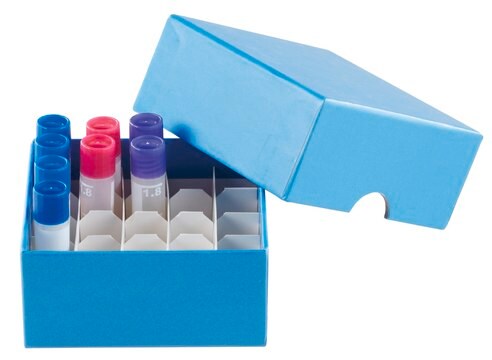推荐产品
生物源
mouse
抗體表格
purified immunoglobulin
抗體產品種類
primary antibodies
無性繁殖
LPA4, monoclonal
物種活性
human, primate
技術
ELISA: suitable
immunohistochemistry: suitable (paraffin)
immunoprecipitation (IP): suitable
western blot: suitable
同型
IgG1κ
UniProt登錄號
運輸包裝
ambient
目標翻譯後修改
unmodified
基因資訊
human ... APOA1(335)
一般說明
Apolipoprotein(a) (UniProt P08519; also known as Apo(a)) is encoded by the LPA gene (Gene ID 4018) in human. Lipoprotein (a)/Lp(a) is composed of apolipoprotein (a)/apo(a) covalently bound to apolipoprotein B-100/apoB via a single disulfide bond on kringle (K)IV type 9 (KIV9) to a site near apoB low density lipoprotein (LDL) receptor-binding site. The LPA gene that encodes Apo(a) appeared late during primate evolution and is not present in non-primate species. Genetically elevated Lp(a) level is a risk factor for cardiovascular disease (CVD) and peripheral arterial disease. Lp(a) is a preferential lipoprotein carrier of oxidized phospholipids (OxPLs) and circulating levels of oxidized LDL are strongly associated with angiographically documented coronary artery disease (CAD). Structurally, Ap(a) contains ten subtypes of KIV sequences, with the KIV2 subtype present in multiple identical repeats, followed by a KV sequence and an inactive protease domain. There are over 40 isoforms of different sizes reported in literature with varying number of KIV2 repeats. The KIV9 contains the cysteine that mediates covalent linkage of Apo(a) to ApoB, while the inactive protease domain competes against plasminogen (PLG) activators (PAs) for PLG binding, thereby preventing the conversion of PLG to plasmin.
特異性
Clone LPA4 targets a 14-a.a. sequence present in human apolipoprotein(a)/Apo(a) KIV-5, KIV-7, and KIV-8 (Leibundgut, G., et al. (2013). J. Lipid Res. 54(10):2815-2830), or Kringle domain 32, 34, and 45 based on the isoform sequence reported by UniProt (P08519), making it possible to use this clone as both the capture (unconjugated) and detection (conjugated) antibody in sandwich ELISA application for the detection of Apo(a) and Lp(a) (ApoB-linked Apo(a)). Clone LPA4 does not cross-react with the highly homologous plasminogen. Note that the target detected by clone LPA4 is not lysophosphatidic acid receptor 4 (a.k.a. LPA-4; UniProt Q99677) encoded by the LPAR4 (a.k.a. LPA4) gene, nor apolipoproteins A-I, A-II, A-IV, and A-V encoded by the APOA1, APOA2, APOA4, APOA5 genes.
免疫原
Human lipoprotein(a)/Lp(a) (Tsimikas, S., et al. (2004). Circulation. 109(25):3164-3170).
應用
Detect Apolipoprotein(a)/Apo(a)/Lp(a) using this mouse monoclonal Anti-Apolipoprotein(a) Antibody, clone LPA4, Cat. No. MABS1284, validated for use in and ELISA, Immunohistochemistry (Paraffin), Immunoprecipitation, and Western Blotting.
ELISA Analysis: A representative lot detected patients plasma Lp(a) levels (5 to 175 mg/dL) as both the capture (5 µg/mL, 50 µL/well; unconjugated) and the detection (1 µg/mL; biotinconjugated) antibody by sandwich ELISA (Courtesy of Dr. Sotirios Tsimikas, M.D., University of California at San Diego, USA).
Immunohistochemistry Analysis: A 1:25 dilution from a representative lot (pre-conjugated with biotin) detected Apo(a) in paraffin-embedded human carotid artery tissue sections (Courtesy of Dr. Sotirios Tsimikas, M.D., University of California at San Diego, USA).
ELISA Analysis: A representative lot was employed as either the capture or detection antibody for the detection of Lp(a) levels in human, chimpanzee, bonobo, gorilla, baboon, and cynomolgus monkey plasma samples, as well as the interaction of OxPL and ApoB with various human Apo(a) transgenes in Tg mice blood samples and purified recombinant human Apo(a) constructs (Leibundgut, G., et al. (2013). J. Lipid Res. 54(10):2815-2830).
ELISA Analysis: A representative lot was employed either as the capture antibody for the detection of Apo(a) and Apo(a)-associated OxPL or as the detection antibody (biotinylated) for the detection of Lp(a) (ApoB-linked Apo(a)) captured by an ApoB antibody in a atherosclerosis study involving uremic mice that express human Apo(a) and ApoB transgene (Pedersen, T.X., et al. (2010). J. Lipid Res. 51(10):2967-2975).
Immunoprecipitation Analysis: A representative lot immunodepleted Apo(a) and associated OxLDL-E06 from patients plasma samples collected immediately before or 6 hrs after percutaneous coronary intervention (PCI), while only ~50% of OxLDL-E06 was found associated and co-precipitated with Apo(a) in the immediate post-PCI time point (Tsimikas, S., et al. (2004). Circulation. 109(25):3164-3170).
Western Blotting Analysis: A representative lot detected recombinant human wild-type Apo(a) and a 8K-IV lysine-binding defective (LBS-deficient) Apo(a) mutant expressed in and purified from transfected HEK293 cells (Leibundgut, G., et al. (2013). J. Lipid Res. 54(10):2815-2830).
Immunohistochemistry Analysis: A 1:25 dilution from a representative lot (pre-conjugated with biotin) detected Apo(a) in paraffin-embedded human carotid artery tissue sections (Courtesy of Dr. Sotirios Tsimikas, M.D., University of California at San Diego, USA).
ELISA Analysis: A representative lot was employed as either the capture or detection antibody for the detection of Lp(a) levels in human, chimpanzee, bonobo, gorilla, baboon, and cynomolgus monkey plasma samples, as well as the interaction of OxPL and ApoB with various human Apo(a) transgenes in Tg mice blood samples and purified recombinant human Apo(a) constructs (Leibundgut, G., et al. (2013). J. Lipid Res. 54(10):2815-2830).
ELISA Analysis: A representative lot was employed either as the capture antibody for the detection of Apo(a) and Apo(a)-associated OxPL or as the detection antibody (biotinylated) for the detection of Lp(a) (ApoB-linked Apo(a)) captured by an ApoB antibody in a atherosclerosis study involving uremic mice that express human Apo(a) and ApoB transgene (Pedersen, T.X., et al. (2010). J. Lipid Res. 51(10):2967-2975).
Immunoprecipitation Analysis: A representative lot immunodepleted Apo(a) and associated OxLDL-E06 from patients plasma samples collected immediately before or 6 hrs after percutaneous coronary intervention (PCI), while only ~50% of OxLDL-E06 was found associated and co-precipitated with Apo(a) in the immediate post-PCI time point (Tsimikas, S., et al. (2004). Circulation. 109(25):3164-3170).
Western Blotting Analysis: A representative lot detected recombinant human wild-type Apo(a) and a 8K-IV lysine-binding defective (LBS-deficient) Apo(a) mutant expressed in and purified from transfected HEK293 cells (Leibundgut, G., et al. (2013). J. Lipid Res. 54(10):2815-2830).
Research Category
Signaling
Signaling
品質
Identity Confirmation by Isotyping Test.
Isotyping Analysis: The identity of this monoclonal antibody is confirmed by isotyping test to be mouse IgG1 .
Isotyping Analysis: The identity of this monoclonal antibody is confirmed by isotyping test to be mouse IgG1 .
標靶描述
499.19/501.3 kDa (mature/pro-form) calculated based on the isoform sequence reported by UniProt (P08519). Note: There are over 40 isoforms of different sizes reported in literature with varying number of KIV2 repeats.
外觀
Protein G purified.
Format: Purified
Purified mouse IgG1 in buffer containing 0.1 M Tris-Glycine (pH 7.4), 150 mM NaCl with 0.05% sodium azide.
儲存和穩定性
Stable for 1 year at 2-8°C from date of receipt.
其他說明
Concentration: Please refer to lot specific datasheet.
免責聲明
Unless otherwise stated in our catalog or other company documentation accompanying the product(s), our products are intended for research use only and are not to be used for any other purpose, which includes but is not limited to, unauthorized commercial uses, in vitro diagnostic uses, ex vivo or in vivo therapeutic uses or any type of consumption or application to humans or animals.
未找到合适的产品?
试试我们的产品选型工具.
儲存類別代碼
12 - Non Combustible Liquids
水污染物質分類(WGK)
WGK 1
閃點(°F)
Not applicable
閃點(°C)
Not applicable
Maximillian A Rogers et al.
Frontiers in cardiovascular medicine, 9, 778919-778919 (2022-02-15)
Lipoprotein(a) (Lp[a]) blood levels >50 mg/dL is a major cardiovascular disease risk factor in humans. Lp(a) associates with increased cardiovascular calcification, a critical pathology with no clinically available drug therapies. The mechanisms through which Lp(a) increases cardiovascular calcification risk remain
Gregory T Jones et al.
Epigenetics, 15(9), 949-958 (2020-04-03)
Changes in whole blood DNA methylation levels at several CpG sites have been associated with circulating blood lipids, specifically high-density lipoprotein and triglycerides. This study performs a discovery and validation epigenome-wide association study (EWAS) for circulating lipoprotein(a) [Lp(a)], an independent
Full Issue PDF.
JACC. Basic to translational science, 5(9), I-CV (2020-10-06)
Benjamin M Morgan et al.
Journal of lipid research, 61(3), 432-444 (2019-12-07)
Plasma lipoprotein (a) [Lp(a)] levels are largely determined by variation in the LPA gene, which codes for apo(a). Genome-wide association studies (GWASs) have identified nonsynonymous variants in LPA that associate with low Lp(a) levels, although their effect on apo(a) function
我们的科学家团队拥有各种研究领域经验,包括生命科学、材料科学、化学合成、色谱、分析及许多其他领域.
联系技术服务部门







